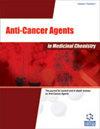Determination of Pralsetinib in Human Plasma and Cerebrospinal Fluid for Therapeutic Drug Monitoring by Ultra-performance Liquid Chromatography-Tandem Mass Spectrometry (UPLC-MS/MS)
IF 2.6
4区 医学
Q3 CHEMISTRY, MEDICINAL
Anti-cancer agents in medicinal chemistry
Pub Date : 2024-04-05
DOI:10.2174/0118715206290110240326071909
引用次数: 0
Abstract
Background: Ultra-performance Liquid Chromatography-tandem Mass Spectrometry (UPLC-MS/MS) is widely used for concentration detection of many Tyrosine Kinase Inhibitors (TKIs), including afatinib, crizotinib, and osimertinib. In order to analyze whether pralsetinib takes effect in Rearranged during Transfection (RET)-positive patients with central nervous system metastasis, we aimed to develop a method for the detection of pralsetinib concentrations in human plasma and Cerebrospinal Fluid (CSF) by UPLC-MS/MS. Methods: The method was developed using the external standard method, and method validation included precision, accuracy, stability, extraction recovery, and matrix effect. Working solutions were all obtained based on stock solutions of pralsetinib of 1mg/mL. The plasma/CSF samples were precipitated by acetonitrile for protein precipitation and then separated on an ACQUITY UPLC HSS T3 column (2.1×100 mm, 1.8 µm) with a gradient elution using 0.1% formic acid (solution A) and acetonitrile (solution B) as mobile phases at a flow rate of 0.4 mL/min. The tandem mass spectrometry was performed by a triple quadrupole linear ion trap mass spectrometry system (QTRAPTM 6500+) with an electrospray ion (ESI) source and Analyst 1.7.2 data acquisition system. Data were collected in Multiple Reaction Monitoring (MRM) and positive ionization mode. objective: Therefore we develop a method for the detection of pralsetinib concentrations in human plasma and CSF by UPLC-MS/MS. Results: A good linear relationship of pralsetinib in both plasma and CSF was successfully established, and the calibration ranges were found to be 1.0-64.0 µg/mL and 50.0ng/mL-12.8 µg/mL for pralsetinib in the plasma and CSF, respectively. Validation was performed, including calibration assessment, selectivity, precision, accuracy, matrix effect, extraction recovery, and stability, and all results have been found to be acceptable. The method has been successfully applied to pralsetinib concentration detection in a clinical sample, and the concentrations have been found to be 475ng/mL and 61.55 µg/mL in the CSF and plasma, respectively. Conclusion: We have developed a quick and effective method for concentration detection in both plasma and CSF, and it can be applied for drug monitoring in clinical practice. The method can also provide a reference for further optimization.利用超高效液相色谱-串联质谱法(UPLC-MS/MS)测定用于治疗药物监测的人血浆和脑脊液中的普拉塞替尼
背景:超高效液相色谱-串联质谱法(UPLC-MS/MS超高效液相色谱-串联质谱(UPLC-MS/MS)被广泛用于阿法替尼、克唑替尼和奥西莫替尼等多种酪氨酸激酶抑制剂(TKIs)的浓度检测。为了分析普拉塞替尼是否对转染重组蛋白(RET)阳性的中枢神经系统转移患者有效,我们旨在开发一种利用 UPLC-MS/MS 检测人血浆和脑脊液(CSF)中普拉塞替尼浓度的方法。方法:该方法采用外标法,方法验证包括精密度、准确度、稳定性、萃取回收率和基质效应。工作溶液均以 1mg/mL 的普拉塞替尼储备溶液为基础获得。血浆/CSF样品经乙腈沉淀蛋白后,用ACQUITY UPLC HSS T3色谱柱(2.1×100 mm,1.8 µm)分离,以0.1%甲酸(溶液A)和乙腈(溶液B)为流动相进行梯度洗脱,流速为0.4 mL/min。串联质谱采用三重四极杆线性离子阱质谱系统 (QTRAPTM 6500+),配有电喷雾离子源 (ESI) 和 Analyst 1.7.2 数据采集系统。数据采集采用多重反应监测(MRM)和正离子模式:因此,我们开发了一种利用 UPLC-MS/MS 检测人血浆和 CSF 中普拉替尼浓度的方法。结果成功建立了血浆和脑脊液中普拉替尼的良好线性关系,发现血浆和脑脊液中普拉替尼的定标范围分别为1.0-64.0 µg/mL和50.0ng/mL-12.8 µg/mL。该方法进行了包括定标评估、选择性、精密度、准确度、基质效应、萃取回收率和稳定性在内的验证,所有结果均可接受。该方法已成功应用于临床样本中普拉西替尼浓度的检测,发现其在CSF和血浆中的浓度分别为475ng/mL和61.55 µg/mL。结论我们开发了一种快速有效的血浆和脑脊液浓度检测方法,可用于临床药物监测。该方法还可为进一步优化提供参考。
本文章由计算机程序翻译,如有差异,请以英文原文为准。
求助全文
约1分钟内获得全文
求助全文
来源期刊

Anti-cancer agents in medicinal chemistry
ONCOLOGY-CHEMISTRY, MEDICINAL
CiteScore
5.10
自引率
3.60%
发文量
323
审稿时长
4-8 weeks
期刊介绍:
Formerly: Current Medicinal Chemistry - Anti-Cancer Agents.
Anti-Cancer Agents in Medicinal Chemistry aims to cover all the latest and outstanding developments in medicinal chemistry and rational drug design for the discovery of anti-cancer agents.
Each issue contains a series of timely in-depth reviews and guest edited issues written by leaders in the field covering a range of current topics in cancer medicinal chemistry. The journal only considers high quality research papers for publication.
Anti-Cancer Agents in Medicinal Chemistry is an essential journal for every medicinal chemist who wishes to be kept informed and up-to-date with the latest and most important developments in cancer drug discovery.
 求助内容:
求助内容: 应助结果提醒方式:
应助结果提醒方式:


